Introduction
In the 21st century, the preservation of the environment has become an area of growing interest for researchers across the globe. Indeed, while modern technological development introduces major improvements in terms of convenience in people’s personal and professional activities, these advancements come at a cost. The immense environmental impact of humanity is a proven fact, as various industries affect the entire planet, including its air, soil, and oceans (Quinlan, 2020). In fact, Quinlan (2020) refers to reducing this detrimental influence as one of the key challenges of the 21st century. However, it is essential to analyze first the scale and the scope of humanity’s environmental impact on specific areas in order to design precise solutions. Experts and scientists from across the world have been working on this issue, but, evidently, its magnitude in the age of globalization is colossal. Therefore, the combined effort of larger initiative groups is required to address the problem in a due manner.
Zooinverse.org is a platform, which serves this particular purpose, utilizing the immense potential of the Worldwide Web, and FISHstory is one of the projects presented on the site. It aims at identifying the exact species of fish caught in the area of Daytona Beach, United States, between the years 1940 and 1970. According to the authors of the project, there is a lack of precise information regarding the population of fish within this period. Consequently, FISHstory enlists individual amateur researchers, asking them to identify the common species in fishers’ photographs taken in the area between 1940 and 1970 (“FISHstory, n.d.). While the project will be able to provide people, including fishing enthusiasts, with the prevalence of certain species in Daytona Beach, its potential extends much further. Hydrosphere experts will be able to analyze the obtained data by comparing it to the presently observed situation in order to distinguish specific patterns in terms of fish species migration. This information will be representative of the ecological situation in the area, as any shifts in the general ecosystem will inevitably find a reflection in the fauna.
Methods
As mentioned above, FISHstory focuses on the data from a specific location, and this format will allow researchers to optimize the work process, resulting in more in-depth analysis. All photos presented for individual research projects are taken in the 1940s-1970s and show people’s fishing trips to Inlet Harbor and Timmons Fish Camp in Daytona Beach, Florida (“FISHstory, n.d.). The study was divided into two stages, and the first one has already been completed, as it appeared simpler. It implied merely counting the number of people and fish in photographs from the database. This way, the authors of the research were able to obtain the general statistics regarding the number of fish caught by an average fishing enthusiast in the area.
The second stage of the FISHstory project is more complicated yet more important in the general context. This individual research requires people to identify the specific species of fish caught and presented in the photographs. As FISHstory enlisted the help of amateur researchers, the second study was adjusted for further simplicity of the identification process. The platform provides a comprehensive tutorial, helping individual researchers become familiar with the procedure. In addition, preliminary studies resulted in a list of the four most common fish species, which were reflected in the interface. Individual researchers are asked to match fish from a photograph with a respectively colored mark. In case the image possesses other, uncommon species or a fish is obstructed, it is possible to select an alternative option, as well. Figures 1-3 demonstrate the interface of the platform, showing the process of fish identification.
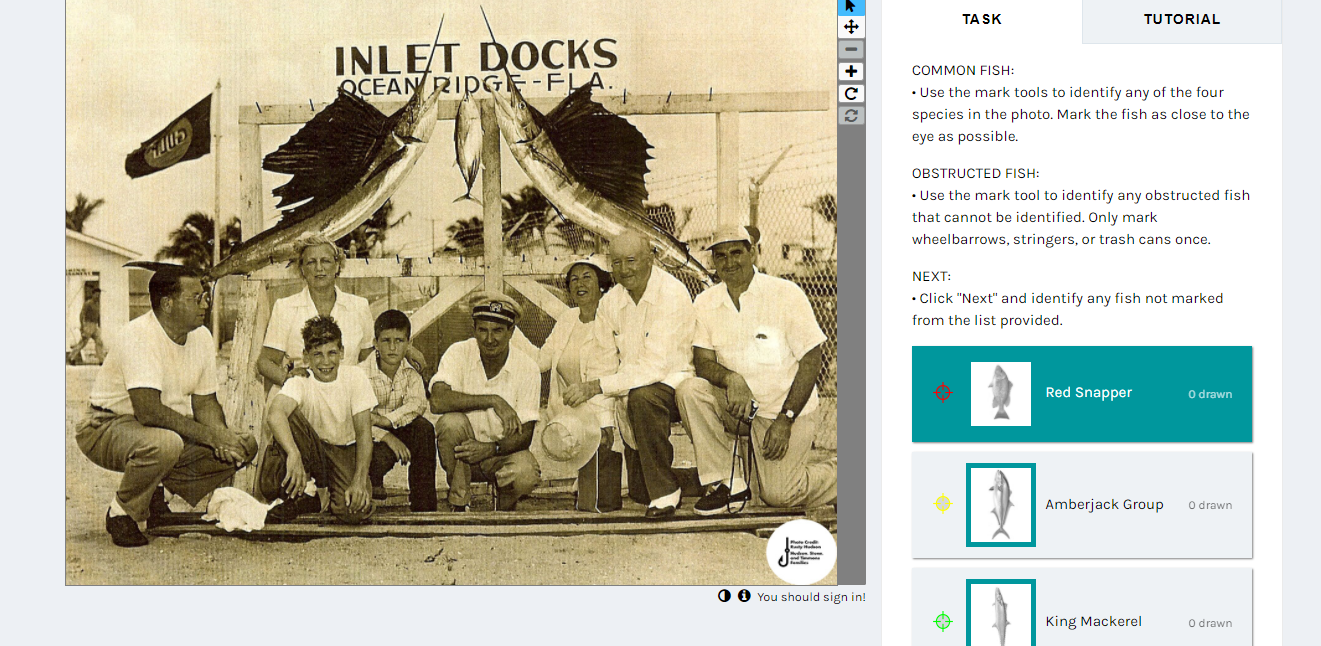
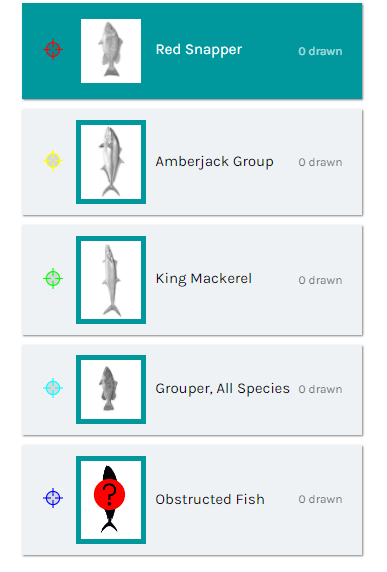
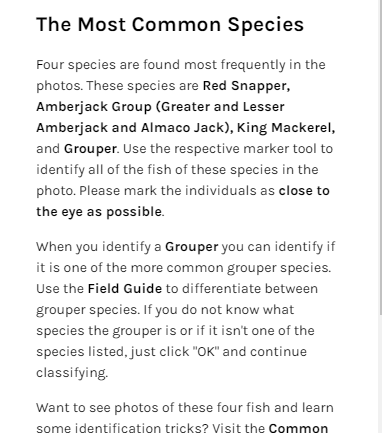
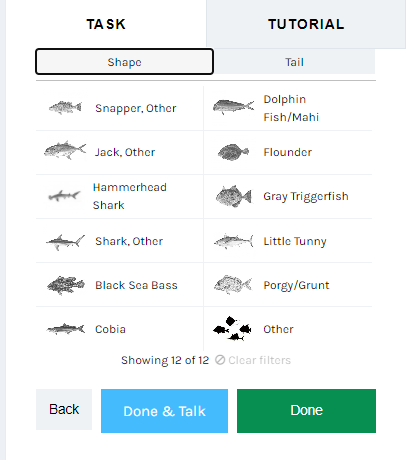
Results
In the course of the present study, the researcher participated in the FISHstory species identification project as an individual. All the guidelines were carefully examined and followed throughout the process. Overall, over 100 photos were examined, each demonstrating over 30 fish on average. As the study revealed, the initial assessment of the FISHstory project’s authors was correct, and the vast majority of fish was from the provided common species list. The information regarding the exact number of identified and obstructed fish was recorded in Table 1. In the concluding stage of the study, the percentage of each variety’s representation in the photographs was calculated. As inferred from the research, the red snapper was the most common fish species caught in the Daytona Beach area between 1940 and 1970. In fact, it occupies the leading position by a fine margin, as compared to groupers, king mackerels, and amberjacks. The number of other varieties found in the presented photographs was rather small and included several hammerhead sharks. The finalized research results are presented in the form of Graph 1.
Table 1. The Number of Fish Identified in the Photographs
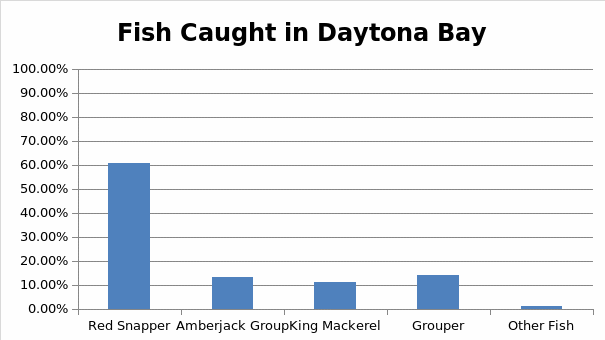
Discussion
The FISHstory project proposed by the Zooinverse.org platform is highly relevant in contemporary environmental studies. The research process resulted in the identification of the percentage of fish varieties caught in Daytona Beach, Florida, between 1940 and 1970. While the scope of the individual study may not be comprehensive, its results can be generalized and extrapolated to the overall situation. In addition, FISHstory, as well as Zooinverse.org, in general, effectively utilizes the potential of modern technological advancements in terms of research projects. Outsourcing is an effective instrument in the contemporary environment, allowing experts to maximize the efficiency of a study with limited resources. Zooinverse.org is an invaluable platform in this regard, as it provides individual enthusiasts to make a contribution to important scientific research. The way in which the data is presented and explained helps the purpose of the project, as well.
Conclusion
In conclusion, studies, such as FISHstory, are of crucial importance for today’s environmental studies. The impact of humanity on nature is reaching critical levels, meaning that the issue is to be addressed in an urgent manner. The Earth’s oceans remain one of the most vulnerable areas in terms of the environmental impact due to massive pollution, and this effect is only going to increase in the coming years. Evidently, technological progress cannot be stopped, but humanity should proceed with caution. Nevertheless, environmental measures should be informed by valid research in order to remain effective. The population of fish is a reliable sign of changes in the ecosystem of the ocean, being a simple yet effective research tool. Therefore, despite its seemingly limited scale, FISHstory is incredibly valuable for environmental studies. The in-depth examination of historical data will allows scientists to discern major changes in the hydrosphere, enabling scientifically-informed, precise practices in the future.
References
FISHstory. (n.d.). Web.
Quinlan, M. (2020). Five challenges to humanity: Learning from pattern/repeat failures in past disasters? The Economic and Labour Relations Review, 31(3), 444–466.